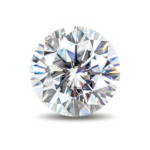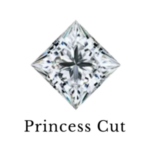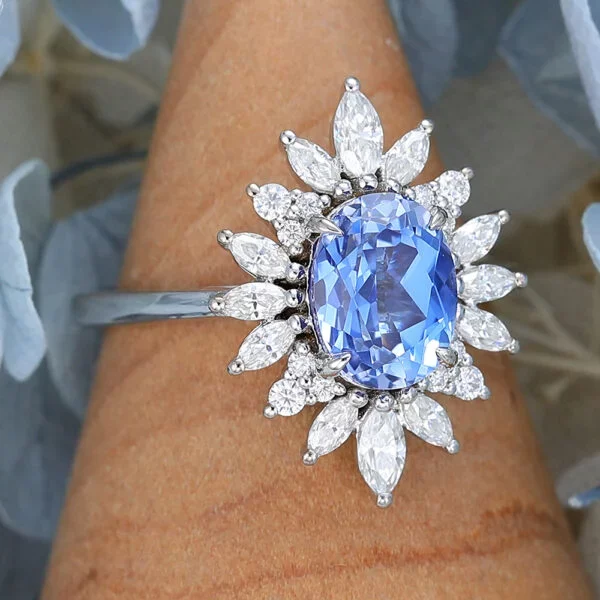In the intricate world of gemstones, the allure and brilliance of gemstones often captivate admirers worldwide. However, behind every shimmering facade lies an artistry as old as civilizati itself – engagement ring cut. This age-old craft, honed over millennia, intertwines precision, skill, and a profound understanding of the gem’s inherent properties. As we embark on this journey, let us delve into the mesmerizing realm of engagement ring cut, exploring its techniques, historical significance, and the remarkable transformation from rough stone to exquisite jewel.
Types of engagement ring cut
There are as many as a dozen types of cuts. Here we mainly introduce these five most common cutting types on the market:
Round cut: It is round in shape and has numerous facets arranged in a symmetrical pattern for maximum light reflection and brilliance. This cut is highly prized for its extraordinary sparkle and fire, making it a great choice for engagement ring cut. A timeless choice for jewelry and other jewelry.

Pear cut: It is drop-shaped and has a smooth outer contour. It is often used for cutting some earrings. This shape can modify the face shape.

Oval cut: The oval cut is an elongated version of the round brilliant cut, with an oval shape and symmetrical facets. It has a similar brilliance to the round cut, but the outline is more slender, which makes the fingers longer when worn as a ring. The illusion of a long, oval cut is versatile and beautiful, making it a popular choice for a variety of gemstone and jewelry styles.

Cushion cut: Cushion cut, also known as cushion cut, is square or rectangular in shape with rounded corners and large facets. It combines the brilliance of round cuts with the softness of square cuts, creating a romantic and elegant look. With a vintage appearance, the cushion cut is prized for its ability to showcase the color and clarity of the stone while providing a unique and distinctive look.

Princess cut: A princess cut is a square or rectangular cut with sharp corners and many facets. It combines the brilliance of round cuts with modern geometric shapes to create a striking, modern look. Princess cut The cut is known for its intense sparkle and clean lines, making it a popular choice for engagement ring cut and other jewelry styles.

Factors to consider when choosing cut
Types and Properties of Gemstones: Different gemstones have unique properties such as hardness, clarity, color, and dispersion. Consider the specific characteristics of a gemstone to determine which cut and shape best enhances its natural beauty
Purpose and occasion: When considering the cutting technique used, we need to consider what the final stone will be used for. For example, engagement rings may mostly use the classic round cut or princess cut. Other statement pieces may require more creative and novel, non-traditional cut shapes. So the type of cut needs to be customized based on the intended use and meaning of the jewelry piece.
Style and preferences: If the gemstone is customized for a person, the buyer’s personal style preferences and preferences also need to be taken into consideration. For example, some people may like classic and timeless cutting designs, while others like niche and novel cuts.
Wear resistance and comfort: Cutting should not only maximize the beauty of the gemstone, but also pay attention to the actual use. Make sure that the chosen design is suitable for daily wear by most people and is comfortable to wear without any foreign body feeling. Especially for rings and bracelets that frequently come into contact with the skin, sharp edges should be avoided, otherwise they will catch hair and clothing in daily life.
Gemstone material: Consider what kind of cutting the gemstone material is suitable for. Some cutting processes may require more material to be wasted during the cutting process, resulting in higher costs. It is necessary to choose a cutting process that maximizes the beauty of the gemstone and minimizes material waste to achieve the best cost performance.

Cutting matches the use of gemstone
If you pay attention to the cutting shapes of some common jewelry on the market, you will find that many jewelry have their own mainstream cutting shape. For example:
Engagement ring: Classic and timeless engagemnet ring cuts like round, princess, and cushion cuts are popular choices for engagement rings because of their versatility and lasting appeal. Pair these cuts with traditional ring settings such as a solitaire, halo, or three-stone setting for a timeless and elegant look. For a vintage-style engagement ring, a unique cut like emerald or Asscher is often chosen, paired with a vintage-style setting that features intricate details and milgrain decoration.
Pendants and necklaces:When choosing gemstone cuts for pendants and necklaces, master cutters will consider the length and style of the chain, as well as the wearer’s neckline. Longer chains and necklaces may come in elongated cuts such as oval or marquise, creating a flattering and elongated effect. For shorter chains and choker necklaces, they’ll consider compact cuts, such as round or pear shapes, for a balanced and proportioned look.
Earrings:Consider matching the shape of the stone to the shape of the wearer’s face for a harmonious effect. For example, oval or teardrop-shaped earrings can complement round faces, while angular shapes like princess or emerald cuts can balance angular features. Stud earrings typically come in a smaller, compact cut, such as a round or princess cut, for a classic and versatile look, while drop earrings may come in a more delicate cut, such as a pear, for added sense of design and elegance.
Bracelet:The engagement ring cut for a bracelet should prioritize wearability and comfort since the bracelet will be in constant contact with the skin. Consider using smaller, more compact cuts in your bracelet design, such as a round brilliant or princess cut, to minimize tangles and ensure a comfortable fit. Bangles and bracelets provide the opportunity to showcase larger, statement stones in bold cuts and shapes (such as cushion or emerald cuts) for a striking and impactful look.

Classic cutting combination
Solitaire set with round-cut diamonds: This timeless combination embodies classic elegance and sophistication. Round brilliant cut diamonds are known for their extraordinary sparkle and fire, while solitaire settings accentuate the stone’s beauty with minimal distraction.
Three-Stone Princess Cut Sapphire: Pair a princess-cut sapphire with a three-stone setting of diamonds for a classic and eye-catching look. The square shape of the princess cut contrasts with the round brilliance of the diamond, while the three-stone setting adds symbolism and meaning to the design
Vintage Style Set Emerald Cut: The emerald cut exudes vintage charm and sophistication, making it perfect for vintage-style settings featuring intricate details and milgrain trim. This combination evokes old world charm and romance, reminiscent of a bygone era.

Conclusion
In conclusion, the art of engagement ring cut is a fascinating blend of tradition, innovation, and craftsmanship. From the classic brilliance of the round cut to the sophisticated elegance of the emerald cut, each gemstone shape and cut serve to enhance its inherent beauty and uniqueness. As we’ve explored, the choice of cut is intricately tied to the intended use of the gem, whether it’s adorning a necklace or gracing a ring. Furthermore, factors like comfort and fashion trends play a pivotal role in shaping the design choices of modern gem cutters. Ultimately, the marriage of gemstone and cut is a testament to the harmonious balance between nature’s treasures and human ingenuity, resulting in timeless works of art that continue to enchant and inspire.

